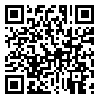دوره 11، شماره 2 - ( 2-1404 )
جلد 11 شماره 2 صفحات 102-91 |
برگشت به فهرست نسخه ها
Download citation:
BibTeX | RIS | EndNote | Medlars | ProCite | Reference Manager | RefWorks
Send citation to:



BibTeX | RIS | EndNote | Medlars | ProCite | Reference Manager | RefWorks
Send citation to:
Maming S, Arafat R, Yusuf S. Therapy by Quranic Recitation for Pain Management in Hospitals: A Scoping Review. JCCNC 2025; 11 (2) :91-102
URL: http://jccnc.iums.ac.ir/article-1-674-fa.html
URL: http://jccnc.iums.ac.ir/article-1-674-fa.html
Therapy by Quranic Recitation for Pain Management in Hospitals: A Scoping Review. نشریه مراقبت پرستاری مددجو محور. 1404; 11 (2) :91-102
چکیده: (1657 مشاهده)
Background: Pain is a frequently encountered issue in hospitals with a high prevalence, causing detrimental effects if uncontrolled. Non-pharmacological approaches like Quranic recitation have been effective in reducing pain. However, further mapping is needed for the clinical application of this therapy in hospitals. This scoping review aims to map Quranic recitation therapy for hospital pain management.
Methods: The literature research was conducted on PubMed, Science Direct, Cochrane Library, Garuda, and Wiley Online Library. We searched the relevant articles written in English between 2014 and 2024. Boolean operators (“AND” and “OR”) were used to optimize the search strategy, focusing on the terms “Quran” OR “Qur’an” OR “Koran” AND “pain.” This scoping review uses the framework by Arkey and O’Malley. The article selection process was conducted using the Rayyan software program. Three individuals carried out the selection process, and the extracted data were then mapped, categorized, and summarized.
Results: The initial database search retrieved 250 articles. Ultimately, 10 studies met the inclusion criteria and proceeded to the next stage of extraction and analysis. The included studies consisted of 4 randomized controlled trials, 5 quasi-experimental studies, and 1 case-control study. Most participants were Muslim adults, reflecting the context of the studies conducted in Muslim-majority countries. One study included neonates, highlighting the potential physiological effects of Quranic recitation beyond religious affiliation. The findings show that Quranic recitation therapy notably decreases pain perceptions, promotes relaxation, soothes the mind, and enhances mental health. It also boosts patient comfort, lowers heart rate, improves oxygen saturation, and alleviates anxiety. The numeric rating scale is commonly used to measure pain, with Surah Ar-Rahman being the most frequently used chapter in the therapy.
Conclusion: Given the benefits of Quranic recitation in pain management, it is hoped that the provision of Quranic recitation therapy can be integrated into hospital pain management protocols as a routinely used complementary therapy. Future research should focus on establishing standardized methodologies for Quranic recitation therapy, including the duration of sessions, specific Surahs used, and uniform outcome measures. Additionally, exploring the therapy’s efficacy in non-Muslim populations would provide valuable insights into its universal applicability beyond cultural and religious contexts.
Methods: The literature research was conducted on PubMed, Science Direct, Cochrane Library, Garuda, and Wiley Online Library. We searched the relevant articles written in English between 2014 and 2024. Boolean operators (“AND” and “OR”) were used to optimize the search strategy, focusing on the terms “Quran” OR “Qur’an” OR “Koran” AND “pain.” This scoping review uses the framework by Arkey and O’Malley. The article selection process was conducted using the Rayyan software program. Three individuals carried out the selection process, and the extracted data were then mapped, categorized, and summarized.
Results: The initial database search retrieved 250 articles. Ultimately, 10 studies met the inclusion criteria and proceeded to the next stage of extraction and analysis. The included studies consisted of 4 randomized controlled trials, 5 quasi-experimental studies, and 1 case-control study. Most participants were Muslim adults, reflecting the context of the studies conducted in Muslim-majority countries. One study included neonates, highlighting the potential physiological effects of Quranic recitation beyond religious affiliation. The findings show that Quranic recitation therapy notably decreases pain perceptions, promotes relaxation, soothes the mind, and enhances mental health. It also boosts patient comfort, lowers heart rate, improves oxygen saturation, and alleviates anxiety. The numeric rating scale is commonly used to measure pain, with Surah Ar-Rahman being the most frequently used chapter in the therapy.
Conclusion: Given the benefits of Quranic recitation in pain management, it is hoped that the provision of Quranic recitation therapy can be integrated into hospital pain management protocols as a routinely used complementary therapy. Future research should focus on establishing standardized methodologies for Quranic recitation therapy, including the duration of sessions, specific Surahs used, and uniform outcome measures. Additionally, exploring the therapy’s efficacy in non-Muslim populations would provide valuable insights into its universal applicability beyond cultural and religious contexts.
نوع مطالعه: مقاله مروری |
موضوع مقاله:
عمومى
دریافت: 1403/8/7 | پذیرش: 1403/11/14 | انتشار: 1404/2/11
دریافت: 1403/8/7 | پذیرش: 1403/11/14 | انتشار: 1404/2/11
| بازنشر اطلاعات | |
 |
این مقاله تحت شرایط Creative Commons Attribution-NonCommercial 4.0 International License قابل بازنشر است. |





